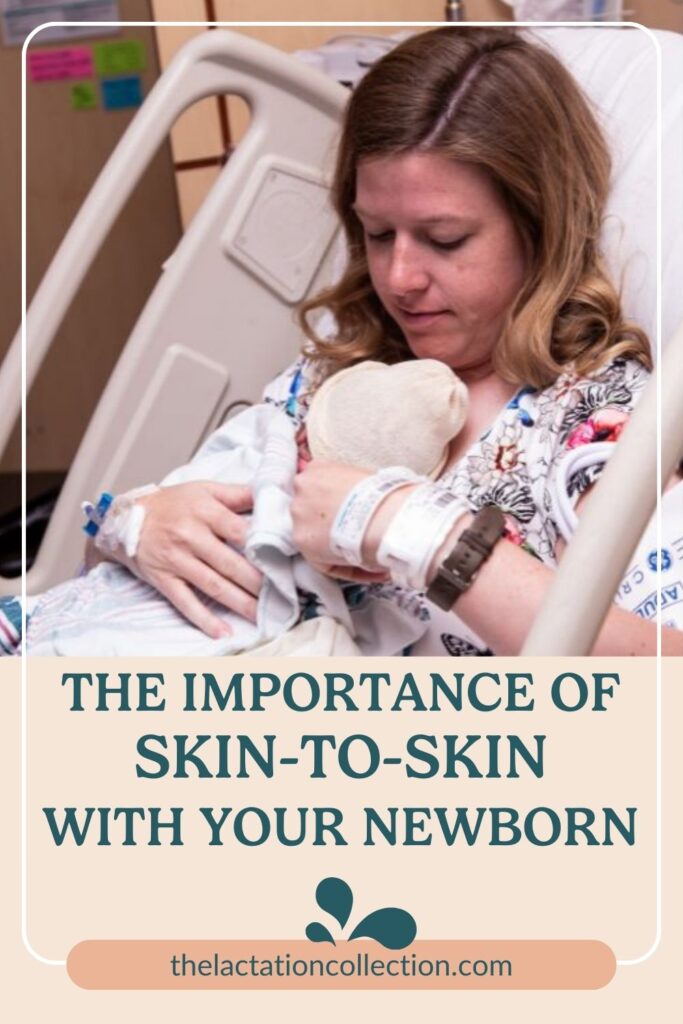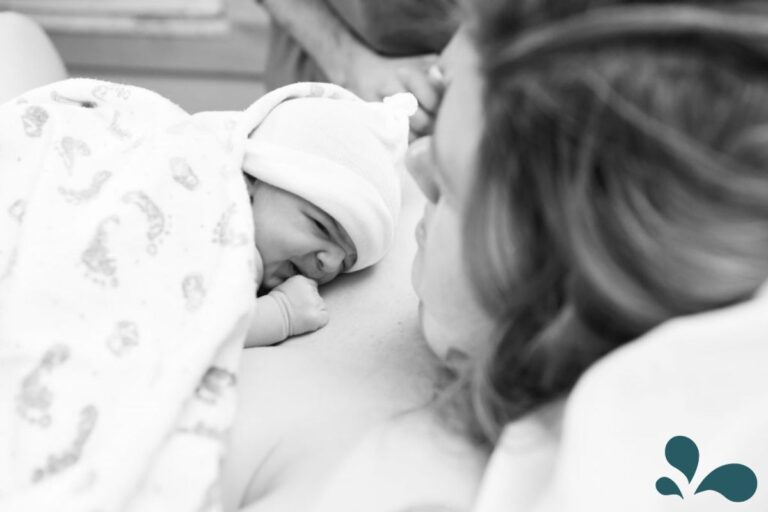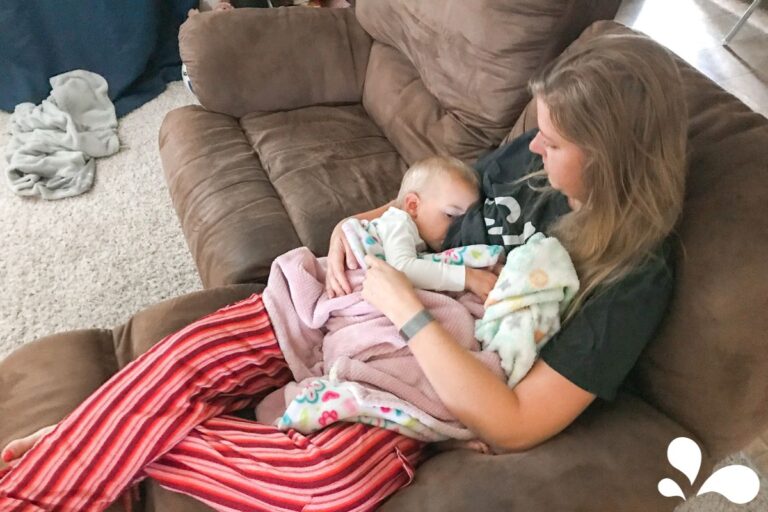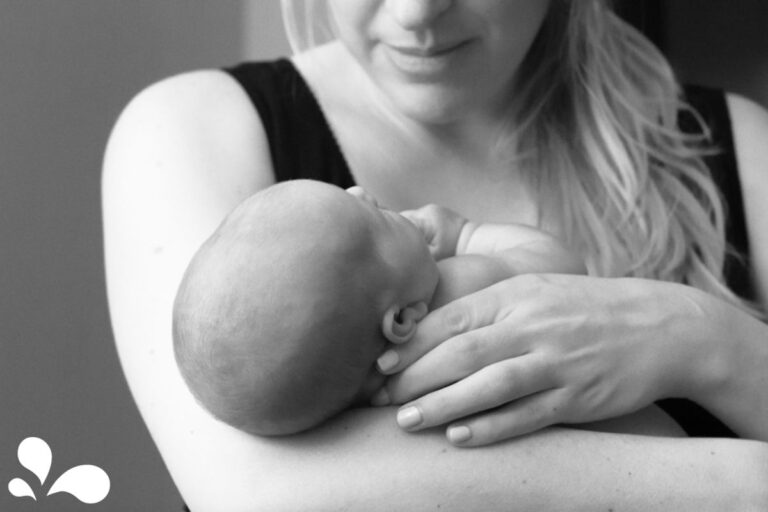We’ll get right to the point – Skin-to-skin contact with your newborn should be a non-negotiable part of your birth plan. It has so many benefits, especially for breastfeeding and building an instant emotional connection with your new babe.
Research shows that skin-to-skin contact is crucial for newborns entering the world. We’ll walk through the research with you and help you figure out a “Plan B” if immediate skin-to-skin contact just isn’t possible.
What is Skin-to-Skin Contact?
Skin-to-skin contact refers to holding your brand new, unclothed, and diapered baby against your bare chest. Skin-to-skin contact after delivery is your first snuggle with your precious new baby – soak it all in, mama.
While snuggling your baby, you or someone else needs to be monitoring the baby’s airways. Make sure to turn the baby’s face to the side so they can breathe well.
The Benefits of Skin-to-Skin Contact
There are so many benefits to skin-to-skin contact! I think it is implanted in us as mothers to want to give babies skin-to-skin contact right after they’ve been born – let me hold that baby as soon as possible, right?
Skin-to-Skin Benefits for the Baby
Immediate skin-to-skin contact for at least two hours right after delivery helps your newborn baby’s body regulate its temperature. Your baby’s heart and lungs will also benefit as their body learns to stabilize.
Research teaches that prolonged skin-to-skin contact with the mother helps babies be better breastfeeders. It helps shorten the time to your first successful latch, promote better suckling, and encourage longer breastfeeding sessions.
Skin-to-skin contact has shown to help babies reduce their response to pain. Heel pricks for blood sampling and other injections aren’t fun for newborns (or anyone!). Skin-to-skin contact has shown to reduce their crying and decrease their heart rate during blood sampling and other painful procedures.

Breastfeeding Benefits for Mom
If your goal is to breastfeed your newborn, skin-to-skin contact will help you and baby be more successful. Utilize longer and earlier sessions of skin-to-skin contact to increase your breastfeeding success. As long as you and your baby are stable, you can start skin-to-skin contact immediately after delivery, and there is no limit to how long you can snuggle that new baby!
Postpartum depression (PPD) is a genuine issue. We’re happy to report that skin-to-skin contact can help decrease your feelings of PPD! Snuggle your baby skin-to-skin as much as possible in the first few days.
The most significant benefit to skin-to-skin contact, in my opinion, is the bond and attachment you’ll create with your newborn baby. If nothing else, skin-to-skin contact will help you connect with your baby, and that’s all that matters.
What if I can’t do Skin-to-Skin because I have a C-Section?
Of course, we hope for the best labor and delivery experience. Still, we know your mama mind is worried about the worst-case scenario. Please talk with your healthcare provider about your Birth Plan and make sure you’re on the same page when it comes to your Plan A and Plan B. Also, know that skin-to-skin contact is an option right after a C-section. Talk to your provider and the staff at the hospital so they know that you would like to have skin-to-skin contact as soon as possible after delivery.
If you have a C-Section or other complications, the doctors will be working on taking care of you. In this case, your partner is the next best option for skin-to-skin contact. Talk with the nurses and your partner and let them know that you’d like to do skin-to-skin contact as soon as possible.

How Long Do I Need to Do Skin-to-Skin?
Timing with skin-to-skin contact is not tricky at all — do skin-to-skin as early as you can for as long as you can!
If you and your baby are stable, talk with your healthcare provider about skin-to-skin for at least the first hour of your baby’s life. As long as you both are stable and happy, you can do skin-to-skin for as long as you want.
Our ultimate goal is the health and safety of you and your baby, so don’t fret if there are delays with skin-to-skin contact. Skin-to-skin contact can be beneficial no matter when you start. You can see benefits from skin-to-skin contact from sessions as short as 20 minutes to as long as 5 hours through the first week of your baby’s life and beyond.

What if Breastfeeding is Still Hard?
No matter how well you set yourself up for success, breastfeeding might still be difficult. The last thing I want you to do is to blame yourself — this is a new skill for you and your baby, and you’ll need to practice and try new things!
We have tons of free resources on the blog and our Instagram for breastfeeding mamas. The best resource we can offer you is our Online Breastfeeding Basics Course. Anna covers everything you need to succeed with breastfeeding in great detail.
We’ve helped hundreds of women learn to breastfeed with confidence. Consider us your ‘breast’ friends!
Enroll now in the Breastfeeding Basics Online Course and start your breastfeeding journey on the right foot. Whether you’re expecting a sweet baby, a brand new mom with a crying newborn, never breastfed successfully, or need a little refresher from the comfort of your own home, this course is for you.








